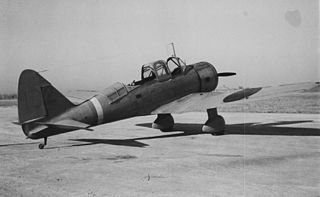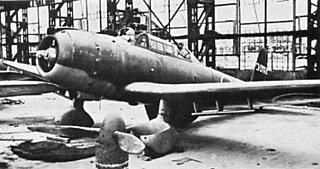
The Aichi B7A Ryusei was a large and powerful carrier-borne torpedo-dive bomber produced by Aichi Kokuki for the Imperial Japanese Navy Air Service during the Second World War. Built in only small numbers and deprived of the aircraft carriers it was intended to operate from, the type had little chance to distinguish itself in combat before the war ended in August 1945.

The Mitsubishi F1M was a Japanese reconnaissance floatplane of World War II. It was the last biplane type of the Imperial Japanese Navy, with 944 built between 1936 and 1944. The Navy designation was "Type Zero Observation Seaplane" (零式水上観測機).

The Aichi D1A or Navy Type 94/96 Carrier Bomber was a Japanese carrier-based dive bomber of the 1930s. A single-engine, two-seat biplane based on the Heinkel He 50, the D1A was produced by Aichi for the Imperial Japanese Navy, remaining in service as a trainer at the time of the attack on Pearl Harbor. The D1A was produced in two variants, the D1A1, and the D1A2.

The Yokosuka K5Y was a two-seat unequal-span biplane trainer that served in the Imperial Japanese Navy during World War II. Due to its bright orange paint scheme, it earned the nickname "aka-tombo", or "red dragonfly", after a type of insect common throughout Japan.

The Mitsubishi B1M was a Japanese torpedo bomber of the 1920s, also known as the Navy Type 13 Carrier-Borne Attack Aircraft. It was designed and built by Mitsubishi and used in combat against China. The aircraft was used by the air services of the Imperial Japanese Navy and Imperial Japanese Army.

The Airspeed AS.6 Envoy was a British light, twin-engined transport aircraft designed and built by Airspeed Ltd. in the 1930s at Portsmouth Aerodrome, Hampshire.

The Tachikawa Ki-36 was a Japanese army co-operation aircraft of World War II. It was a two-seat, low-wing monoplane with a single piston engine and fixed, tailwheel-type undercarriage.

The Yokosuka B4Y,, carrier torpedo bomber was used by the Imperial Japanese Navy Air Service from 1936 to 1943. The B4Y replaced the Mitsubishi B2M2 and was the last biplane bomber used operationally by the Imperial Japanese Navy. The Allied reporting name was "Jean".

The Aichi E16A Zuiun was a two-seat reconnaissance seaplane operated by the Imperial Japanese Navy during World War II.

The Kawanishi E7K was a Japanese 1930s three-seat reconnaissance seaplane. It was allocated the reporting name Alf by the Allies of World War II.
The Hiro G2H was a 1930s Japanese bomber or reconnaissance monoplane designed and built by the Hiro Naval Arsenal for the Imperial Japanese Navy.

The Mitsubishi K3M was a trainer built by Mitsubishi which was used by the Imperial Japanese Navy in an extremely wide variety of roles, including light transport, liaison aircraft, utility aircraft and occasionally light bomber. Its Allied reporting name was Pine.

The Mitsubishi Ki-18 was an unsuccessful and unsolicited attempt by Mitsubishi to meet a 1934 requirement issued by the Japanese Army for a modern single-seat monoplane fighter suitable to the needs of the Imperial Japanese Army Air Force. During this competition, Nakajima entered the Nakajima Ki-11, and Kawasaki entered the more maneuverable Kawasaki Ki-10 biplane. The competition was won by Kawasaki, but the new fighter was not accepted by the IJAAF with much enthusiasm.

The Mitsubishi Army Type 92 Reconnaissance Aircraft (九二式偵察機) was a Japanese short-range reconnaissance aircraft of the 1930s designed by Mitsubishi for the Imperial Japanese Army Air Force. A total of 230 were built, serving between 1933 and 1936. A parasol monoplane, the Type 92 was the first military aircraft powered by an engine both designed and manufactured in Japan to enter service.

The Yokosuka D3Y Myojo was a Japanese two-seat dive bomber/trainer designed and built by the Yokosuka Naval Air Technical Arsenal. Derived from the Aichi D3A, it was made nearly entirely of wood in an attempt to conserve valuable resources. Upon Japan's surrender, the project came to a halt with only a few aircraft delivered as the Navy Type 99 Bomber Trainer Myojo Model 22.
The Yokosuka E5Y was a single-engine Japanese seaplane used for reconnaissance. The E5Y was also built by Kawanishi as the E5K
The Mitsubishi J4M Senden or Navy Experimental 17-Shi Otsu B Type Interceptor Fighter Senden, Allied reporting name Luke, was a Japanese World War II fighter aircraft proposed by Mitsubishi for use by the Imperial Japanese Navy. The J4M project did not proceed beyond the design stage.
The Kawanishi E13K, company designation AM-19, was a Japanese 1930s three-seat reconnaissance floatplane.
The Watanabe K8W was a Japanese floatplane trainer designed and built by Watanabe for the Imperial Japanese Navy.

The Mitsubishi Ka-12 or B4M was a Japanese carrier-based torpedo bomber of 1934. Two prototypes were built by Mitsubishi for the Imperial Japanese Navy. A development of the company's 3MT10 of 1932, the design differed primarily in the use of a radial engine and metal wing, which made the whole aircraft significantly lighter and faster. However, the design could not realise its potential as the wing was inefficiently stiff and the B4M was not selected for production. The competing Yokosuka B4Y was chosen to serve on the Navy's aircraft carriers instead.















